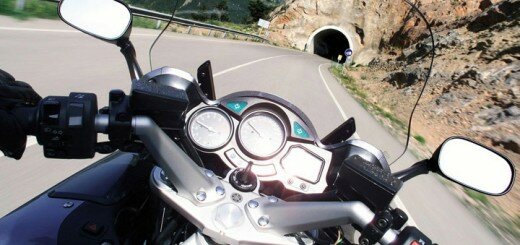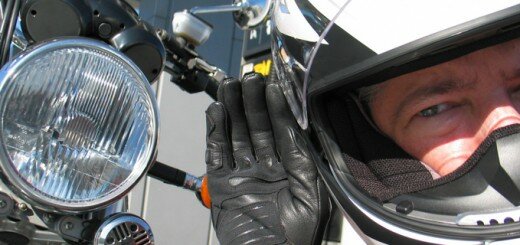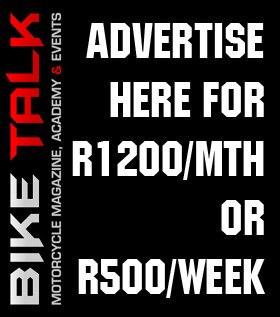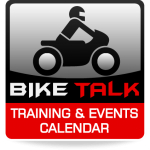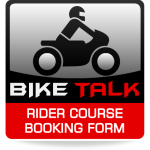Most riders would agree that while the sensation of speed on a motorcycle is exhilarating, stopping quickly, efficiently and safely is absolutely essential. To promote effective braking, Honda has incorporated a number of advances in braking technology: disc brakes, multiple-piston brake calipers, Combined Braking Systems (CBS), Anti-lock Braking Systems (ABS) and Combined ABS for sport riders.
However, a number of motorcycles still feature manual braking systems that place a premium on effective rider operation. In short, even with the many technological braking aids available, the operator will always remain the key component for effective stopping. So, to review some braking basics and also cover some finer points of braking on the street we turned to three-time AMA Superbike Champion Reg Pridmore. Reg has been conducting riding schools for more than a quarter of a century, helping thousands of riders to gain better operational techniques for improved motorcycle control. Here Reg shares some of his coaching techniques with us, and also share information from his book Smooth Riding, which he has developed to help riders gain proper motorcycling skills.
Reg Pridmore:
“The front brake handles almost all the business of stopping, so it’s important to become familiar with the limits of front-wheel braking. Some people may be a bit apprehensive about using the front brake, so explore its use a little at a time, in an upright position. Gradually increase your braking applications. The confidence and safety you will gain will be worth the effort.
Cover the front brake
“Proper use of the front brake starts with good hand and finger position. Place the right-hand index and middle fingers so they ‘float’ over the top of the front brake lever. In the event of a braking emergency, you don’t want to lose any reaction time reaching from the grip to the brake lever.
Smooth transitions
“For smooth and stable bike operation, make the front brake and throttle work in harmony during throttle transitions by rocking your hand from the wrist with a gentle rolling motion. I call this the rocking horse motion. You can start practicing this action on a stationary motorcycle, in the garage. Develop a gentle rolling motion with the wrist: from a stop, as you accelerate, gradually release the brake. For slowing, roll off the throttle as you squeeze the brake. This gives the motorcycle much better input than grabbing the brake lever or slamming the throttle closed—actions that can destabilize the bike. This rocking horse movement has a settling effect on the suspension, which is why it’s used so much in racing.
“Static practice is highly recommended to get the timing down for rolling off the throttle, squeezing the brake lever and smoothly stopping; this practice can be done while sitting on your bike in your garage, and it can be very beneficial. Practice the braking steps in this order: First smoothly roll off the throttle and begin gradually applying the front brake, then begin gradually applying the rear brake fractions of a second later, and don’t pull in the clutch until you are just about at a full stop, which allows engine braking to assist your efforts.”
Use the rear brake too
“I’m a tireless advocate of using the front brake. Nonetheless, I hate it when people tell me they never use the rear brake. Although the front brake does the bulk of the stopping work, the rear brake can supply that last 10 percent of the slowing action, plus it has a stabilizing effect on the chassis. Honda’s Combined Braking System is designed to have exactly this effect. The key to effective rear brake use is to learn its sensitivity. Don’t panic and stab at the rear brake; apply it in a progressive manner. Keep your foot back on the peg, not poised over the rear brake pedal where a panic reaction could cause a problem. Unlike the front brake, where you want your fingers to rest on the lever for instantaneous response, you don’t want the rear brake to be this accessible and you don’t want it to be the primary activated stopper.”
A note about ABS (Anti-lock Braking Systems)
“ABS is very effective in building confidence, especially for someone who is scared of locking up the wheels. ABS gives riders the confidence to approach this point because you know the system won’t allow the skid to occur. However, as ABS has become more common, I’ve seen that riders have gotten lazy with brake actuation and that the ‘grab and stab’ technique is back, stronger than ever—and that’s not good. Whether or not your bike is equipped with ABS, the key to effective braking is to control your panic when a surprise situation crops up: plug in your brain and use smooth input, like you would without ABS.”
Practice, practice, practice
“The ability to avoiding panic and applying maximum braking comes only when you develop a plan and put it into practice. You need to practice, especially when you feel you don’t need it. How do you practice braking? First off, pick a safe location. Next, let your imagination take over and create emergency scenarios: What if a car pulled out here? What if I suddenly encounter a patch of gravel? Visualize an emergency stopping point and then use smooth, progressive application of the brakes to bring the bike to a halt as quickly as possible. Then use the same braking point over and over again to see if you can shorten the stopping distance. Experiment with just using the front brake, then just the rear, and then a combination of both, realizing that control should be natural and paramount.
“I recommend that you work toward the limits of braking regularly. If the rear wheel locks up momentarily, you’ll be able to get away with it. With the front, you’ll hear a tell-tale howling noise as the tyre approaches the limits of traction. Become attuned to this, but don’t push it too hard—once the front locks up, you’ll likely crash. It’s a fine line.
Know your limits, and operate within them.”
On a personal note, I’ve trained and seen a lot of people who ride without proper knowledge or operation of both the front and the rear brakes.
People, you just don’t know what you are letting yourself in to, practise these techniques over and over again because it might just be the difference between life and death on the next ride you take.
Practise makes perfect; get it done!



